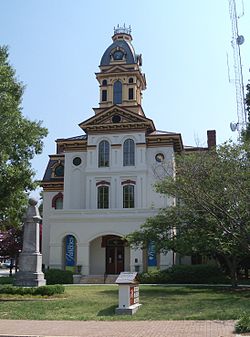State capitol

- North Carolina State Capitol. The Capitol currently houses the offices of the Governor of North Carolina. The legislature relocated to its current location in the North Carolina State Legislative Building in 1963.
In 2017, Governor Roy Cooper unsuccessfully petitioned the North Carolina Historical Commission to move the following three Confederate monuments from the grounds of the state Capitol to the Bentonville Battlefield, a Civil War site in Johnston County. [3] [4] The Commission found that the 2015 law prohibited their removal, but recommended signage to add context to the monuments, including noting that slavery was a cause of the Civil War. The Commission also found unanimously that the Capitol monuments are "an overrepresentation and over-memorialization" of the Confederacy and Civil War in North Carolina. The Commission urged the state’s Department of Natural and Cultural Resources to plan and raise money for a monument recognizing the contributions of African Americans to North Carolina's history. [5] On June 19, 2020, the two statues at the base of the monument were toppled by protestors. The protestors proceeded to drag one statue to the streets and hang it from a street light. [6]- Monument Removed June 21, 2020 [7] - North Carolina State Confederate Monument (1895), also known as the Soldiers and Sailors Monument. "This 75-foot-tall monument to fallen Confederate soldiers is located on the State Capitol grounds. At the top of the column is a statue depicting a Confederate artillery soldier holding a gun. Near the bottom of the column are two statues, one representing the Confederate infantry and the other a Confederate cavalryman. Two 32 pounder naval cannons stand on each side of the monument." [8] Contains the Seal of North Carolina. Front: "To Our Confederate Dead." Rear: "First at Bethel, last at Appomattox".
- Monument Removed June 21, 2020 [9] - Monument to North Carolina Women of the Confederacy, also called Confederate Women's Monument (1914). "The seven foot tall monument, made possible through a private donation, honors the hardships and sacrifices of North Carolina women during the Civil War. A bronze sculpture depicts an older woman, a grandmotherly figure, holding a book as she sits next to a young boy holding a sword. It sits on top of a granite base with bronze bas-relief plaques. The woman, representing the women in the South as the custodians of history, imparts the history of the Civil War to the boy. The two relief plaques portray the Civil War; the eastern side shows soldiers departing for war and leaving their loved ones behind, while the western side depicts a weary or injured Confederate soldier returning home." [10] In 2019, a protester placed Ku Klux Klan hoods on the two figures. [11]
- Monument Removed June 21, 2020 [7] - Henry Lawson Wyatt Monument (1912). He was the first Confederate soldier to die in battle. Sculpture by Gutzon Borglum. Inscriptions:
Front: HENRY LAWSON WYATT / PRIVATE CO. A / BETHEL REGIMENT / NORTH CAROLINA VOLUNTEERS / KILLED AT BETHEL CHURCH / JUNE 10, 1861 / FIRST CONFEDERATE SOLDER | TO FALL IN BATTLE IN THE | WAR BETWEEN THE STATES.
Rear: WYATT'S COMRADES / IN DASH TO BURN THE HOUSE / GEORGE T. WILLIAMS / JOHN H. THORPE / ROBERT H. RICKS / ROBERT H. BRADLEY / THOMAS FALLON / ERECTED BY THE NORTH CAROLINA | DIVISION, UNITED DAUGHTERS | OF THE CONFEDERACY. / JUNE 10, 1912
Base, east face: GORHAM. Co. FOUNDERS. [12]
- In addition, the following Civil War monuments are on the Capitol grounds:
- A statue of Confederate Colonel Zebulon Baird Vance, Governor during the Civil War, 1862–1865.
- Monument to Civil War Captain and North Carolina legislator Samuel A'Court Ashe (1940), two plaques on a large granite block. [13]











